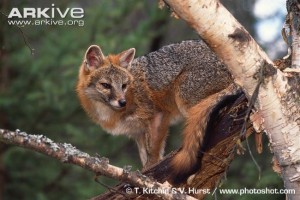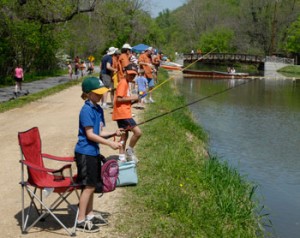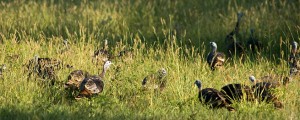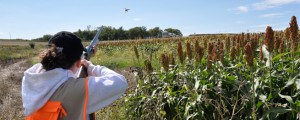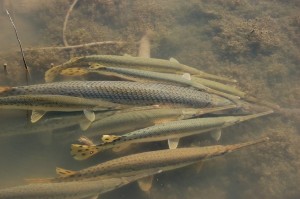By Ted Williams
High Country News
Some interests potentially inconvenienced by the Endangered Species Act are so terrified of the law that it often succeeds best when threatened but not invoked.
So it may be with ongoing efforts to save the greater sage-grouse.
In 2011, the U.S. Fish and Wildlife Service gave states, private landowners, the Forest Service and the Bureau of Land Management a choice: Come up with acceptable recovery plans before September 2015, or the bird gets an ESA listing.
Beset by oil, gas and wind development, overgrazing, habitat fragmentation, climate change, wildfire and invasive plants, sage-grouse are hurting in Wyoming, Oregon, Idaho, Nevada, Montana, Utah and Colorado. They’re barely hanging on in Washington, California and the Dakotas. They’ve been wiped out in Nebraska andArizona.
The nightmare vision of distant, desk-bound feds dictating land use across 11 Western states has united former adversaries in the largest landscape-planning effort in the history of wildlife management. Six thousand square miles of habitat have been protected on 950 ranches. Plans for state and federal lands, still in the works, are generally fair and getting better.
But if Colorado and Utah don’t get their acts together, they may leave the U.S. Fish and Wildlife Service little choice but to roll out its Endangered Species Act howitzer.
In Colorado, the main problem is Gov. John Hickenlooper, who unfortunately co-chairs the sage-grouse task force for the Western Governors’ Association. In an apparent effort to win re-election, he is trying to ingratiate himself with extractive industry, an impossible task because he’s a Democrat. The state doesn’t have a plan or even a strategy for helping sage-grouse.
“Colorado relies on habitat mitigation, but that’s a tool, not a plan,” says Ed Arnett, energy-development point man for the Theodore Roosevelt Conservation Partnership. “ColoradoParks and Wildlife has fine sage-grouse specialists who haven’t been fully engaged by the governor’s office.”
“There’s a disconnect in Colorado,” declares Audubon Wyoming director Brian Rutledge, one of the main architects of sage-grouse recovery, especially in Wyoming, the state that’s setting the standard for effective efforts. “Hickenlooper thinks he’s being pro-industry. But I have industry people who tell me that what we’ve done in Wyoming is the best thing that’s happened to them because now they’ve got a rule book.”
Utah at least has a plan, though an inadequate one. It uses a three-track approach: Avoid disturbance of the leks, or bird courtship display areas; minimize other disturbances; and, as a last resort, mitigate damage. These are worthy goals, but everything is voluntary. Regulations are needed, too, especially on state lands.
In Utah, Miles Moretti was deputy director of the state’s Division of Wildlife Resources until 2006, when he left to take the reins of the Mule Deer Foundation. Now he’s a key player in a range-wide stakeholder effort called the Greater Sage-grouse Initiative. What, you might ask, have mule deer got to do with sage-grouse? They’re one of at least 350 other species that also depend on our vanishing sagebrush sea.
“I see private landowners willing to work to keep the bird off the list,” says Moretti. “But I don’t have a lot of hope for Utah’s state lands. The state just wants to stop anything that keeps it from developing land and raising money.”
Rather than trying to prevent listing with effective on-the-ground habitat restoration, Utah officials have hired a lobbyist for $2 million to urge Congress to delay listing.
That lobbyist is Ryan Benson, attorney for and co-founder of Big Game Forever — a tentacle of the Orwellian-named Sportsmen for Fish and Wildlife, which in 2012 seduced the state Legislature into appropriating half a million dollars for a $50 coyote bounty. In 2012 and again in 2013, the Legislature appropriated $300,000 to hire Big Game Forever and Don Peay, founder of Sportsmen for Fish and Wildlife, to lobby the U.S. Congress against “wolf reintroduction” in Utah, something the feds had never contemplated.
To figure out what needs to be done for sage-grouse, Utah Gov. Gary Herbert tapped as his public-lands czarina Kathleen Clarke, who, as George W. Bush’s BLM director, endeared herself to the oil and gas industry by hosting a drilling free-for-all on some of the West’s best sage-grouse habitat. The priority for Utah, she told theSalt Lake Tribune, is to whip up some science (“honest and true”) that “refutes” existing data.
The obstinacy and denial of Colorado and Utah threaten not just sage-grouse and not just the creatures that depend on sagebrush. They threaten creatures all over the globe, because among the countless victims of an Endangered Species Act listing would be the act itself — a law Congress is already itching to emasculate.

